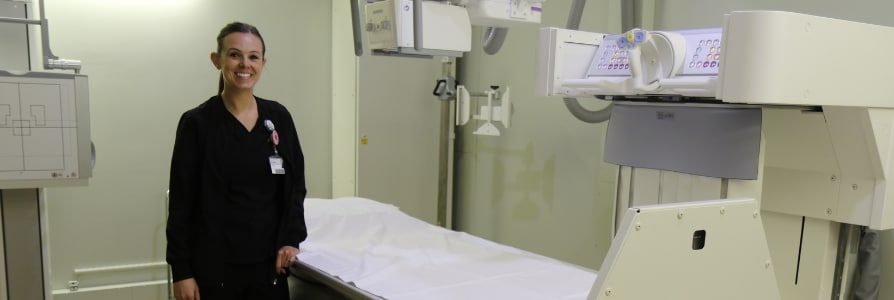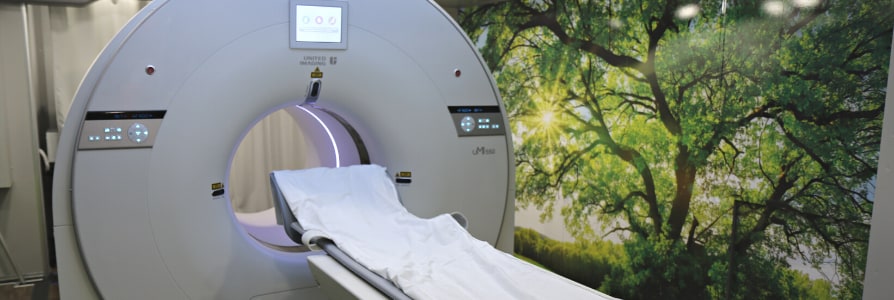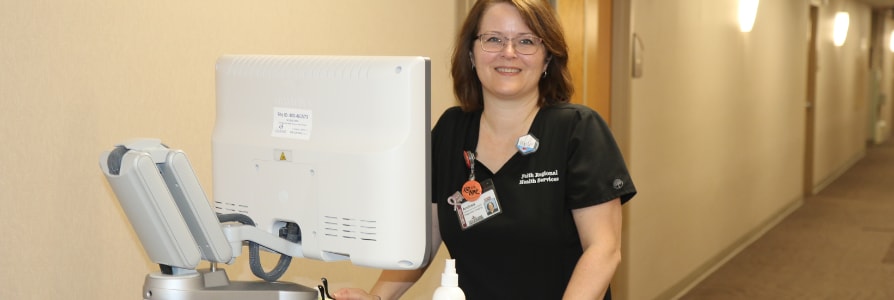Sometimes your provider will recommend imaging or radiology services to help diagnose a potential condition or illness. We offer a full range of imaging and radiology services here at Faith Regional, including:
Adenosine Stress Test
If you are unable to exercise on a treadmill, your doctor may prescribe this type of stress test. Medication will be given to you that increases blood flow to your heart. Your provider can then compare blood flow to your heart when it’s at stress versus at rest.
Angiogram/Arteriogram
With an angiogram, a thin, flexible tube is inserted into an artery in your leg to inject contract dye-making your arteries and veins visible on the x-ray. This test is used to detect blockage or narrowing of vessels.
Cardiac Catheterization
A small, flexible tube called a catheter is inserted in a blood vessel in your groin, arm, or neck. With cardiac catheterization, the catheter is then threaded through your blood vessel into your heart. Once the catheter is placed, your provider can perform different tests or procedures, such as an angiogram, stent placement, fractional flow reserve, intravascular ultrasound, and a biopsy.
Carotid Ultrasound
Sound waves are used to examine blood flow through your carotid arteries. Your provider may order a carotid ultrasound if you have a transient ischemic attack (TIA), certain types of strokes, or are at risk of a stroke due to another medical condition.
Chest X-Ray/Radiography
A very small dose of ionizing radiation is used to produce pictures inside the chest. This test can be used to evaluate your lungs, heart, and chest wall or may be used to diagnose shortness of breath, persistent cough, fever, chest pain, or injury.

Computerized Tomography (CT Scan)
Experience fast, safe and precise results in comfort with our 160-slice CT scanner. It features a large bore and industry-leading dose-reduction software to minimize radiation exposure while still producing high-quality images. Your doctor may order a CT scan to help:
- Diagnose muscle or bone disorders, such as bone tumors and fractures
- Identify a precise location of a tumor, infection, or blood clot
- Guide procedures, such as surgery, biopsy, and radiation therapy
- Detect and monitor diseases and conditions such as cancer, heart disease, lung nodules, and liver masses
- Monitor the effectiveness of certain treatments, such as cancer treatments
- Detect internal injuries and internal bleeding
Dobutamine Stress Echocardiogram
If unable to exercise, a medication called dobutamine can be used to make the heart beat faster. An echocardiogram is then used to produce images of your heart under stress.
Echocardiogram
Sound waves are used to produce images of your heart. Your doctor may recommend an echocardiogram to assess your heart beating and pumping blood to check for certain heart conditions.
Electrocardiogram (ECG)
Electrodes are placed on certain spots on your chest, arms, and legs and then connected to an ECG machine to assess the electrical activity of your heart. Your provider may recommend this test to:
- Look for the cause of chest pain
- Identify irregular heartbeats
- Determine the overall health of your heart
- Assess how your implanted pacemaker is working
- Determine how well certain heart medications are working
- Get a baseline tracing of your heart’s function
No electricity is sent into your body.
Electrophysiology (EP) Study
This is a series of tests that examine your heart’s electrical activity. These tests may include taking a baseline measurement of your heart’s electrical activity, sending signals to cause your heart to beat faster or slower, giving medicines to see how they affect your heartbeat, mapping your heart, or performing cardiac ablation.
Event Monitor
This is a wearable cardiac event monitor that your provider may recommend to diagnose tachycardia. This portable device records your heart’s activity only during arrhythmias (irregular heart rhythms).
Holter Monitor
This is a wearable monitor that your doctor may recommend to track your heart rhythm.
Magnetic Resonance Angiography (MRA)
This test evaluates blood vessels and helps identify abnormalities. Instead of using radiation, the exam uses injected contrast material to produce pictures of your blood vessels.
Magnetic Resonance Imaging (MRI) Scan
Experience fast exams tailored to your body type and specific needs. Our Magnetom® Aera 1.5 T Open Bore MRI offers superb image quality and comfort. The open bore design reduces the closed-in feeling of traditional MRIs and the short design allows many exams to be performed with your head outside the system.
You’ll also experience a quieter exam with our noise reduction software.
An MRI can be used to examine your organs, tissues, or skeletal system. Its high-resolution images will help your doctor diagnose a variety of problems.

Nuclear Medicine
Very small amounts of radioactive materials are used to examine your organ function and structure. This type of imaging is often used to help diagnose and treat abnormalities in their very early stages.
Nuclear Medicine Treadmill Stress Test
A radioactive tracer is used to assess blood flow in your heart as well as the strength of the heart muscle. It’s typically performed with an exercise stress test on a treadmill or a stationary bike.
Positron Emission Tomography (PET)
A tiny amount of radioactive substance is used to examine biochemical changes in your organs or tissues that can identify the onset of disease. It’s mostly used for heart conditions, brain conditions, and cancer.

Stress Test
You’ll walk on a treadmill or ride a stationary bike while your heart rhythm, blood pressure, and breathing are monitored. This test can help your providers guide treatment decisions, determine how well your heart treatment is working, and diagnose the severity of your heart condition.
Thallium Stress Test (nuclear stress test)
Thallium will be administered to you by an IV which shows the movement of blood throughout your body. Images are taken of your heart at rest and after your exercise. This test can reveal coronary blockages, damage from a heart attack, an enlarged heart, as well as other heart complications.
Tilt Table Test
A tilt table will enable your provider to monitor your heart rate and blood pressure while in a horizontal position and a vertical position for set periods of time. Your provider may prescribe this test if you’re experiencing repeated, unexplained episodes of lightheadedness, dizziness, or fainting.
Transesophageal Echocardiogram (TEE)
To produce a clearer image of your heart, your provider may recommend a transesophageal echocardiogram. In this test, a probe with a transducer is placed down your esophagus. Sound waves are then used to produce images of your heart without having to pass through skin, muscle, or bone tissue. Certain conditions are better seen with a TEE.
Ultrasound
High-frequency sound waves are used to produce images. You might mostly associate ultrasounds with monitoring a baby’s development during pregnancy, but ultrasounds can be used for a wide variety of reasons, including:
- Diagnose gallbladder disease
- Evaluate blood flow
- Guide a needle for a biopsy or tumor treatment
- Examine a breast lump
- Check your thyroid gland
- Detect genital and prostate issues
- Assess joint inflammation
- Evaluate metabolic bone disease
- View the uterus or ovaries
Most ultrasounds are performed using the device outside your body but some involve placing a device inside your body.

Venous Ultrasound
Sounds waves are used to produce images of the veins in your body. It’s commonly used to search for blood clots.
Once your imaging test is complete, your provider's office will contact you with the results when they are available. Some results are available shortly after the test is performed, other results may take a few days. You can also review your test results online as soon as they are available with your One Chart l Patient account.